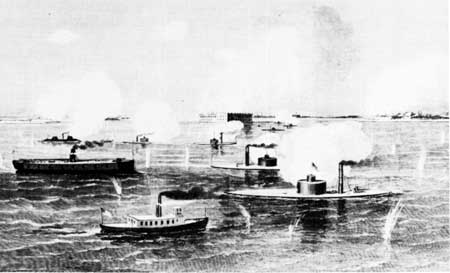|
FORT SUMTER National Monument |
 |

Contemporary artist's conception of Ironclad
attack, April 7, 1863. The flagship New Ironsides is
at left center.
From Harper's Weekly, May 2, 1863.
Federal Ironclads
Attack Fort Sumter
On April 5, 1863, a fleet of 9 Federal ironclads, armed with 32 guns "of the heaviest calibres ever used in war," appeared off Charleston bar. Seven were of the single-turret "cheesebox on a raft" monitor type; one was a double-turreted affair; the flagship New Ironsides was an ironclad frigate. With the ebb tide, on the afternoon of the 7th, the "newfangled" iron clads steamed single file up the main ship channel east of Morris Island.
The weather was clear and bright; the water "as stable as of a river." By 3 o'clock, the Weehawken, the leading monitor, had come within range, and Fort Moultrie opened fire. The Passaic, second in line, responded. Fort Sumter held fire, guns trained on a buoy at the turn of the channel. When the Weehawken came abreast of that point, all the guns atop Sumter's right flank let loose, followed by all the guns on Sullivan's Island, at Fort Moultrie, and at Cummings Point that could be brought to bear.
It was too much for the ironclads, slow and unwieldy, possessed of limited vision, and operating in a narrow and uncertain channel. In the course of the 2-1/2-hour fight, only one came as close as 900 yards to Fort Sumter. To the 2,209 rounds hurled against them, the ironclads were able to return only 154, of which only 34 found the target. These breached and loosened the right flank parapet for a length of 25 feet and pocked the walls elsewhere with craters up to 2-1/2 feet deep. But it was far from enough; Fort Sumter remained strong and secure. In the meantime, five of the ironclads were seriously disabled by the accurate fire, and one, the Keokuk, sank the following morning in the shallow water off Morris Island. In a daring exploit sometime later, Confederate troops recovered the guns of the Keokuk and mounted one at Fort Sumter.
Admiral Du Pont had "attempted to take the bull by the horns but had failed." The North, so confident of victory, was stunned at a time when the general military situation gave cause for gloom. The war in the East had been bloody and indecisive till now; the news from the West was bad.
Federal authorities looked to a combined operation to seize Morris Island and from there demolish Fort Sumter. With Fort Sumter reduced, the harbor could be entered.

|
|
Last Modified: Mon, Dec 2 2002 10:00:00 am PDT |


